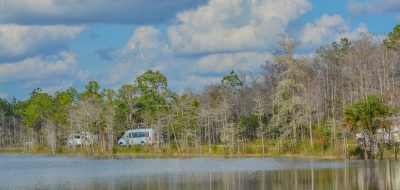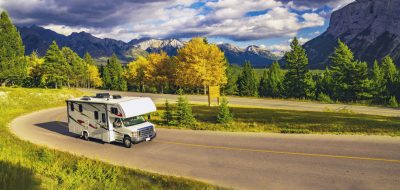Last week we looked at driving in adverse weather, that most have encountered at one time or another. Today we will discuss the chance encounter of coming face to face with a real severe weather event, a tornado. (Link to last week’s part 1: http://blog.rv.net/2009/11/rv-driving-in-adverse-weather-conditions-part-1-of-2/ )
Tornados, as we know them today, are one of the most violent short term weather events out there. With wind speeds as high as 300 MPH or more, there is no doubt of their possible affect to anything in their way. One of the real issues is the lack of warning prior to it striking. The weather services do however issue warnings of “the possibility of tornado development”. But, these announcements seem so common across the country during the summertime that they seem to lose their punch.
So, what are some of the possible tell-tale signs of an approaching tornado? The following events have been seen prior to a tornado.
- An unusual threatening green color in the sky.
- Clouds moving at a greater than normal speed in a rotating or converging pattern.
- If it hails during a period of tornado warnings, there is a strong chance of a tornado immediately after. If no warnings are posted there will probably be no tornado activity.
- A strange quiet occurring shortly after the passing of a thunderstorm.
- Observation of a funnel like image. This could be a cloud structure or just debris spinning in clear air.
- The sound of rushing air or large waterfall. As it approaches, the sound turns to a roar with a tone similar to a combination of a train and a jet aircraft.
I experienced one tornado in Georgia some years ago. The slickly greenish sky was visible for some time prior, I would say for 20 minutes or so. That period of time, however, would vary depending on the speed the twister is actually making toward you. A visual sighting is, however, not always possible as the tornado may be somewhat imbedded in the approaching weather or the geographic characteristics of the area may obscure the view. If, however, you see the funnel, and it appears to stay in the same relative position, it may be headed directly for you. You should not try to out run it in the opposite direction. They can move very quickly, anywhere from a stand still to in excess of 60 MPH.
In North America, tornados generally move from the southwest to the northeast. This is not always the case. They do, on occasion veer east, southeast or back north and even northwest. With this in mind, if it seems to be heading directly towards you from a western direction, driving about 90 degrees left of the approaching twister would probably be your best course. Basically keeping the funnel straight off the right side of your vehicle. That is, if a suitable road going that way was available. If inevitably, you can not get out of its way, exit the vehicle and move a good distance from it. Seek shelter in a building if possible, or if not available find an area lower than that of the roadway such as a ditch. Lie in the recession, away from any trees, and cover your head with your hands.
But, what if you are caught in your RV or tow vehicle, with no time to exit and no place to go? Make sure everyone has their seatbelt on. Duck as low as you can below the dash level. If you are in an A class motor home, and you have an adequate number of seatbelts in the sofa located further back, go there. This will reduce your exposure to all the glass upfront and possibly flying debris. With a seatbelt fastened, bend as low as you can below the window level. Be sure everyone with you knows where the emergency escape exits are located and how to operate them.
There is no guaranteed answer to assure safety if caught in such a violet weather event. We can only do our best and hope for the best. Prevention is probably the number one tip when it comes to any violet weather event. Always check the expected weather conditions along the day’s route. Monitor a local radio station should the sky’s look threatening in any way. Consider getting a weather alert dedicated radio. Stay very alert to changing conditions, such as an increase in wind speed, a rapid wind direction shift, cloud texture and color, unusual cloud shapes and any other tell-tale signs.
So, have you ever been caught in a tornado or like storm? If you have, let’s hear about it.
With an Eye on The Weather – Lug_Nut – Peter Mercer







Dale Olson
Severe Weather.
We just started with an RV. A Winnebago Rialta. As life would dictate it, our first-ever day on the road last spring would lead to 8 hours of driving in the rain, winds from all directions, and those funny looking rotating clouds.
We decided to stop for the day about 80 miles West of St Louis on I 70. We found an RV park off the free-way with plenty of trees. When we got to the parking sight, the manager called us to the Ladies Side of the bathhouse to wait out a newly issued tornado warning. No tornado, a little more wind whistling in the trees, and of course, rain…
Of the 12 days we were on the road, 10 of them were rain, the remaining 2 were driving into a head wind. It seemed that most of the places we wanted to visit were wet and cool. What else could we expect for the last week of April and the first week of May. For the wind, rain, cool weather, our little Winnie averaged a fuel consumption level, ( I keep records in our laptop ) for the whole trip ( 5000 miles ) was 17.5 mpg.
Was it a pleasant trip? – You Bet! – I got to spend 12 days riding with my wife (Best Friend). At the end of the trip, we were still laughing and talking with one another. Would I do it again? In a heart beat! I’d prefer to do it without the rain and strong winds.
Thanks,
Dale O 🙂
Lug_Nut
Mike, You were very lucky. Thanks for sharing your experience with us.
Lug_Nut
catchesthewind, Great point. Thank you for the input.
Mike
In eastern Kansas, a couple of years ago, we got caught on a westbound highway in a thunderstorm – not too bad, but then we looked out the passenger window when the rain parted suddenly and saw a tornado on the ground about a mile away. Dead calm where we were for a minute or two then we got caught in the wind outflow. Watched an 18-wheeler dance sideways in front of us and were hanging on for dear life ourselves. There was no warning until just about the time we saw the twister. Those winds were later estimated at 70+ mph by a helpful officer.
Moral – thunderstorms on the prairies in summer – if you find yourself in one, PULL OVER safely or get off the freeway – wait it out.
catchesthewind
Every experience shared makes us all just that much a better driver.
Lug_Nut
Dogleg, Thank you for sharing your experience with us. I’m glad all worked out in a very dangerous situation. Thank you for your valued input.
Dogleg
As Lug_Nut points out, there are dangers aside from the winds of the actual tornado itself. For example, living in North Texas – at the southern end of “Tornado Alley”, we have many chances to witness what happens at some distance from the funnel. About four years ago, we were returning home from a trip out West, driving along I-20, (which is generally SW-to-NE from its junction with I-10 in West Texas) to Dallas. Rain almost all the way, getting heavier and heavier the closer to Dallas we drove. We’d heard about tornado warnings all day, and the lightning shows were getting more spectacular the farther East we drove. Thought about pulling over many times, but didn’t. When we were about halfway between Abilene and Dallas, all heck broke loose, and it seemed like a giant bucket of hailstones just dumped itself out onto the highway and us. Drivers were suddenly slowing to a near stop on the highway; a few were pulling off onto the shoulder on either side. I could barely make out the shoulder, and I’m sure the 18-wheelers behind me couldn’t see much better, but I just had to pull off anyway because I just could not see the road. I prayed they could see that my 4-ways were on, and recognize I was stopped. The hail lasted more than 5 minutes and collected on the roadway like so much snow…maybe 3 inches. Found out later that the tornado had passed us 2-3 miles away, but the threat to us from the rain, lightning, straight-line wind, and finally the intense hail was very serious. We should have pulled far off the road at an exit, parked, and waited for the storm to pass by us. That would have reduced the threats of colliding with other vehicles, or us colliding with a stationary obstacle, at least.
Best regards,